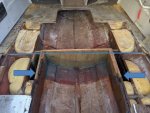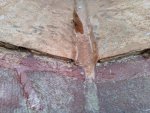Hello, my 1997 21' Mariah had her boating season cut short this summer when it looked to have a fuel tank leak. I pulled it, and sure enough the aluminum tank was in terrible shape with numerous pits and a definite leak. Further, upon pulling the carpet back I realized it was probably a good time to make some deck repairs anyway. In several areas, the protective top layer of glass had cracked or completely broken up, exposing the deck to the elements.In one spot in particular (near my cutout in the picture), the floor staples had rusted out and one of the boards was lifting at the seam and had a little bit of delamination.
Since the original fuel tank was custom made by an out of business manufacturer, I looked a little at having a custom aluminum replacement made. Unfortunately I have yet to even hear back with any bids, and with the industry trend seeming to go towards plastic, I looked at that a bit harder. Only issue was the stock molds that would fit would require me to reduce my fuel tank size from 40 gallon down to 29 gallon. But, since I figured I needed to get a bit dirty with the deck repair, I thought I might as well reconfigure things while I was in there and pulled the trigger on a 39 gallon Moeller. The reconfiguration seems relatively limited as the replacement tank is a tad long, I just need to move the bulkhead that separates the tank area from the ski locker back about 1.5 inches.
Back to the deck, my inexperience may be showing here but I think the damage done thus far is relatively limited. I cut out a small area near the delamination and the wood was very dry. From what I can see (didn't do a core sample), the "no rot" stringers also seem to be holding up well. So, that leads me to think I can get away with replacing the easily accessible portions of the deck. I linked a couple of pictures (sorry had trouble doing attachment to this post) where I drew with red lines my plan on what I would replace.
https://i.imgur.com/8t4LZlD.jpg
https://i.imgur.com/Ij1BW0K.jpg
So, my plan of attack is:
Also, assuming my plan is reasonable, I had just initial questions about laying the new deck. How do the new floorboards tab into the existing material that I leave behind? I'm talking specifically about where the red lines run in my pictures. It seems neither board will have its edges sitting on stringers/struts, so they won't have great support where they meet. Is that a problem, or will throwing some PB in there and re-glassing the top harden it up enough that it won't be a problem?
Since the original fuel tank was custom made by an out of business manufacturer, I looked a little at having a custom aluminum replacement made. Unfortunately I have yet to even hear back with any bids, and with the industry trend seeming to go towards plastic, I looked at that a bit harder. Only issue was the stock molds that would fit would require me to reduce my fuel tank size from 40 gallon down to 29 gallon. But, since I figured I needed to get a bit dirty with the deck repair, I thought I might as well reconfigure things while I was in there and pulled the trigger on a 39 gallon Moeller. The reconfiguration seems relatively limited as the replacement tank is a tad long, I just need to move the bulkhead that separates the tank area from the ski locker back about 1.5 inches.
Back to the deck, my inexperience may be showing here but I think the damage done thus far is relatively limited. I cut out a small area near the delamination and the wood was very dry. From what I can see (didn't do a core sample), the "no rot" stringers also seem to be holding up well. So, that leads me to think I can get away with replacing the easily accessible portions of the deck. I linked a couple of pictures (sorry had trouble doing attachment to this post) where I drew with red lines my plan on what I would replace.
https://i.imgur.com/8t4LZlD.jpg
https://i.imgur.com/Ij1BW0K.jpg
So, my plan of attack is:
- Demo the deck along the lines in the photos
- Move bulkhead and install tank
- Install deck
- Install replacement carpet and put her back in the water
Also, assuming my plan is reasonable, I had just initial questions about laying the new deck. How do the new floorboards tab into the existing material that I leave behind? I'm talking specifically about where the red lines run in my pictures. It seems neither board will have its edges sitting on stringers/struts, so they won't have great support where they meet. Is that a problem, or will throwing some PB in there and re-glassing the top harden it up enough that it won't be a problem?




























